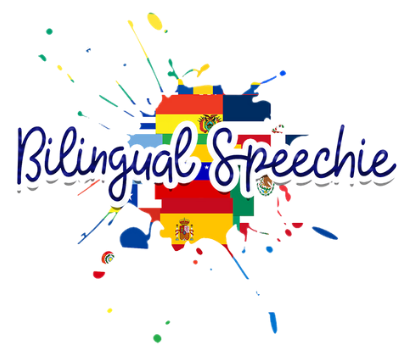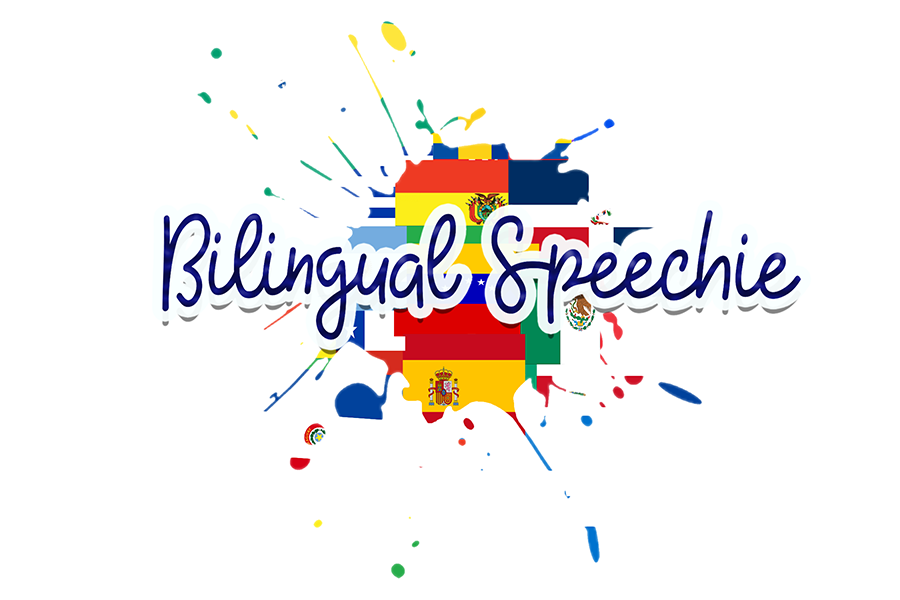por Liliana Diaz noviembre 09, 2020 13 Comentarios
Let's face it, report writing can get a little repetitive, especially when utilizing the same assessments over and over again. A strategy that has been super helpful for me, and that has saved me lots of time, is to save all of my report writing blurbs. Over the years, I have collected and saved blurbs that I have written which I can easily copy and paste into a report and edit/revise as needed. These blurbs include bilingual assessment templates, language sample templates and blurbs that explain difference versus disorder. I am sharing with you some useful templates that bilingual SLPs often request from me. Please note that these templates are written in MY OWN words, with the exception of the "Proceed with caution blurbs for the PLS-5 and CELF-4 (these blurbs were obtained from the leadersproject.org website and the link has been provided below). Therefore, you should edit the blurb in your own words in order to fit your writing style and to accurately represent your student's needs. Simply copy and paste the blurbs below.
ITALK Survey
The ITALK survey was utilized to interview the child’s parents and gather input from the family about the child’s speech and language performance in Spanish and English at home. This information is used to guide a decision making regarding which language to use for the assessment. The clinician asked questions about the child’s vocabulary, articulation, grammar and comprehension in each language (English & Spanish). Individual scores were obtained for each domain depending on the parent’s response. The scores for the five areas were summed and then divided by the number of scored responses. A higher score for a language indicates that it is likely the child’s better language at home. If the highest average is equal to or greater than 4.18 then this indicates that there are no parent concerns about the child’s language development. If the highest average score is lower than 4.18 than further speech-language assessment is indicated. The student obtained the highest average score in ______, which was ______, indicating that there are (no) parent concerns and ______ is the preferred language at home.
BESA Phonology Subtest
The Bilingual English-Spanish Assessment (BESA) was administered to assess the student’s phonological skills. The assessment includes two measures (English & Spanish) in order to gather an understanding of the student’s articulation skills of each language. The student is required to spontaneously label the picture presented.
BESA Language
The Bilingual English-Spanish Assessment (BESA) is a comprehensive speech and language assessment developed for Spanish-English bilingual children ages 4 through 6 years. The BESA consists of a pragmatic language activity and three subtests (Phonology, Morphosyntax, & Semantics) in two languages. The Pragmatic activity allows for the identification of children who may encounter difficulties in situations that require the child to be an active participant. The Phonology Subtest is a single-word phonological assessment which includes two measures (English & Spanish) and assesses the student’s articulation skills of each language. The Morphosyntax subtest assesses cloze and sentence repetition tasks to target grammatical morphemes and sentence structures that were predicted to be difficult for children with language impairment in English or Spanish. The Semantics subtest targets six tasks: analogies, characteristic properties, categorization, functions, linguistic concepts, and similarities and differences which allows the clinician to gain an understanding of the student’s lexical system. The BESA was normed on Latino children in the United States who were exposed to Spanish, English or both languages. Bilingual speakers are assessed using separate language administration and scoring procedures. The normal range is 1.5 standard deviations (SD) below or above the mean. A standard score within the normal range (85-115) places a child within normal limits (WNL) for the child's age.
Blurb when Assessing Articulation
It should be noted that most phonological processes are shared across Spanish and English with the exception of tap/trill deviation which is only seen in Spanish languages and vocalization which can only be seen in English. Differences among phonological processes only occur at the ages in which they are suppressed. In addition, all phonemes are shared among the Spanish and English language with the exception of the following English phonemes: v, h, sh, j, ð, z, r, voiceless th, ng, z. It should be noted that any articulation errors on ________ may be attributed to the influence of the child’s first language and is considered a difference not a disorder. A true articulation disorder occurs when misarticulations on specific phonemes are shared across languages. The student presented with the following articulation errors which are considered true errors : ___________________
PLS-5
The Preschool Language Scales-Fifth Edition (PLS-5) is developed for children from birth through 7 years 11 months of age and is composed of two standardized scales (Auditory Comprehension and Expressive Communication). The Auditory Comprehension (AC) scale is used to evaluate the scope of a child's comprehension of language ranging from precursors for language, vocabulary, concepts, morphology, syntax, complex sentences, comparisons, inferences, and emerging literacy. The Expressive Communication (EC) scale is used to determine how well a child communicates with others including vocal development, social communication, object labels, descriptive labels, quantities, prepositions, grammatical markers, syntax, emerging literacy and integrative language skills. The normal range is 1.5 standard deviations (SD) below or above the mean. A standard score within the normal range (85-115) places a child within normal limits (WNL) for the child's age.
Source: Test Review: PLS-5 Spanish Leadersproject.org
It should be noted that despite the PLS-5's attempt to design a comprehensive language battery, results obtained from administration are not valid due to lack of information as to how tasks and items were deemed appropriate, and an insufficient reference standard. It is also important to note that although the discriminant accuracy was considered “fair,” the PLS-5 Spanish does not discriminate typically developing children from children with a language disorder. Instead, it discriminates children who scored below an arbitrary cutoff score on the PLS-4 Spanish. According to the Manual de Administración y Puntación, “For an overall evaluation of a child’s language ability, the results of the PLS-5 should be supplemented with a COMPLETE family and academic history, primary caregiver interview, analysis of spontaneous language sample, classroom behavioral observations, observations of peer interactions, evaluations of pragmatic and interpersonal communication abilities, and the results of other linguistic and metalinguistic abilities tests” (p. 7). Due to cultural and linguistic biases (e.g. exposure to books, cultural labeling practices, communication with strangers, responses to known questions, etc.), and assumptions about past knowledge and experiences, this test should only be used to probe for information and not to identify a disorder or disability. Therefore, SCORES should not be calculated and used as the SOLE determinant of classification or referral for special education services.
CELF-4 Spanish
The Clinical Evaluation of Language Fundamentals Spanish Fourth Edition (CELF-4) was administered to assess the student's receptive and expressive language skills in Spanish.The test consists of 9 subtests which include: Conceptos y Siguiendo Direcciones, Estructura de Palabras, Recordando Oraciones, Formulacion de Oraciones, Classes de Palabras, Estructura de Oraciones, Vocabulario Expresivo, Repeticion de numeros and Secuencias Familiares.
In the Conceptos y Siguiendo Direcciones subtest, the objective is to evaluate the student's ability to interpret spoken directions of increasing length and complexity which contain concepts that require logical operations such as remembering the names, characteristics, and order of the mentioned objects and to identify from among several pictured choices that were mentioned.
In the Estructura de Palabras subtest, the objective is to evaluate the student's ability to apply word structure rules or morphology to mark inflections, derivations, and comparison and to select and use appropriate pronouns to refer to people, objects and possessive relationships.
In the Recordando Oraciones subtest, the objective is to evaluate the student's ability to listen to spoken sentences of increasing length and ccomplexity and repeat the sentences without changing word meanings, inflections, derivations, comparisons or sentence structure.
In the Formulacion de Oraciones subtest, the objective is to evaluate the student's ability to formulate complete, semantically and grammatically correct spoken sentences of increasing length and complexity using given words and contextual constraints imposed by illustrations.
In the Clases de Palabras subtest, the objective is to evaluatte he student's ability to understand relationships between words that are related by semantic class features and to express those relationships.
In the Vocabulario Expresivo subtest, the objective is to evaluate the student's ability to name illustrations of people, objects, and actions.
In the Entendiendo Parrafos subtest, the objective is to evaluate the student's ability to sustain attention and focus while listening to spoken paragraphs of increasing length and complexity and to understand oral narrative and text and be able to answer/think critically about the questions and the content of the information given.
Source: Test Review: CELF-4 Leadersproject.org
The CELF-4 Spanish was designed to assess the presence of a language disorder or delay in Spanish speaking students aged 5;0-21;11. Despite the CELF-4 Spanish’s attempt to design a comprehensive language battery, results obtained from administration are not valid due to lack of information as to how tasks and items were deemed appropriate, and an insufficient reference standard. The insufficient reference standard in turn affects the diagnostic accuracy of the CELF-4 Spanish, including the sensitivity, specificity, and likelihood ratios, rendering these measures invalid. Therefore, even if the CELF-4 Spanish were a valid, reliable and unbiased assessment, it lacks sufficient discriminant accuracy in order to determine the presence or absence of a language disorder.
Items from the CELF-4 Spanish rely heavily on vocabulary dependent and labeling tasks. As a result, this test will likely identify socioeconomic status and second language acquisition issues, not a disorder or disability, in children learning English as a second language and those from homes of lower socioeconomic status. According to the Examiner’s Manual, test administrators should be aware of a number of factors that may affect the performance of a student from diverse cultural and linguistic backgrounds. Some clinicians may choose to use items from the CELF-4 Spanish as probes to determine receptive and expressive language skills. In this case, modifications to the standard test administration may be used. According to the Examiner’s Manual, “for an overall evaluation of a student’s language ability, the results of the CELF-4 Spanish should be supplemented with a complete family and academic history, parent interview, results of other and informal measures, an analysis of a spontaneous language sample, the results of other linguistic and metalinguistic abilities tests, classroom behavioral observations, observations with peers, and evaluations of pragmatic and interpersonal communication abilities” (p. 18).
Due to cultural and linguistic biases (for example, exposure to books, repetition of unfamiliar syntactic structures, cultural labeling practices, communication with strangers, responses to known questions, etc.) and assumptions about past knowledge and experiences, this test should only be used to probe for information and not to identify a disorder or disability. Therefore, scores should not be calculated and used as the determinant of classification or referral to special education services.
The student's exposure and usage of _____ and ____ was measured by determining who the child lives with, their relationship to the child, the languages spoken and how much time is spent with the child in a typical day. On a typical day, ________ is exposed to (hears) _______ 0% of the time and is exposed to ______ 0% of the time through interactions with his/her immediate family members and teachers in school. In a typical day, the student communicates (speaks) in ______ 0% of the time and in ______ 0% of the time.
Students acquiring a second language must acquire Basic Interpersonal Communication Skills (BICS) and Cognitive Academic Language Proficiency (CALP). BICS relates to context embedded social language, which is acquired within 2 years. CALP is the context reduced language of academics, which is acquired in about 7 years, but can take up to 10 years to acquire. CALP requires students to use active cognitive strategies to perform a task. A BICS/CALP gap can lead educators to believe a student has a language disorder or learning disability, especially as the educational environment becomes less contextualized in older grades. The academic language used in CALP is also less available in the home, in which social language is more commonly used. ________ has not yet achieved CALP but has the foundational language skills in ______ to successfully develop CALP within the expected time range.
The wordless picture book “Frog, Where are you?” by Mercer Mayer was used to elicit a language sample in English and Spanish. Each language sample was analyzed using the Narrative Scoring Scheme (NSS) which is an assessment tool that provides an index of the student’s ability to produce a structurally sound and coherent narrative. NSS consists of a scale from 15 for each area including introduction, character development, mental states, referencing, conflict resolution, cohesion, and conclusion. An average was taken to determine the student’s level where 0-1 is minimal, 2-3 is emerging, and 4-5 is proficient.
A Nonword Repetition Task (NWRT) was administered in order to assess the student’s phonological working memory, speech perception, phonological assembly, and short-term memory. NWRTs provide an understanding of the student’s phonological awareness, word learning skills, and overall language acquisition. It is a useful tool that is less culturally and linguistically biased when compared to standardized language assessments and helps identify students with a developmental language disorder. During the NWRT, the clinician asked the student to repeat a series of nonwords of differing syllable length and complexity of sound combinations, thereby assessing linguistic abilities that have not been taught or learned previously. The number of correct consonants was analyzed, and the student obtained __________ which indicates that ___________.
The School-Age Language Assessment Measure (SLAM) are a set of language elicitation cards and questions which were utilized in order to obtain a language sample and assess the client's expressive/receptive language skills which includes the student's ability to make inferences, formulate a narrative, problem solve, formulate complex sentences/ cohesive ideas, demonstrate perspective taking and understand theory of mind. The SLAM picture cards were designed as a tool to be used in assessing language for preschool and elementary school aged children. These cards elicit an evidence-based language sample that can be analyzed using the "Guidelines for Analysis." The student was presented with the ________________ picture cards. The student obtained a score of ____ on the guidelines for analysis which indicates that the student _________.
A play-based language observation checklist was utilized to assess the student's play skills, nonverbal communication, attention skills, expressive/receptive vocabulary, language comprehension, and expressive language in both languages. By assessing a student's play-skills, we are able to gain insight about the student's communication skills in a non-bias and culturally appropriate manner.
In the area of play, the student is observed during play with a variety of objects presented in the assessment room. A child's ability to play will allow insight to the child's pre-academic and developmental skills.
In the area of receptive language,
Based on developmental norms, __________ (insert the norms for the client's age/ remember that developmental norms as the same across all languages). (i.e., a 3-year-old should be able to attend to name being called from another room understand simple wh- questions, and understands most simple questions pertaining to her activities and environment.) When compared to developmental norms for the student's age, the student demonstrates strength/difficulty _____.
In the area of expressive language,
Based on developmental norms, __________ (insert the norms for the client's age/ remember that developmental norms as the same across all languages). (i.e., a typical 3-year old should have approximately 1000 words in his/her expressive vocabulary and communicate in 3-4 word utterances. A 3 year old should also begin to utilize plurals, utilize present progressive forms, present tense auxiliaries and utilize possessive forms. In addition, 3-year olds should be able to answer more complex questions logically, such as “who,” “why,” “where,”and “how.") When compared to developmental norms for the student's age, the student demonstrates strength/difficulty _____.
Based on the English assessment results, observations and parent intake information gathered during the parent interview, the student is a (i.e., simulatenous bilingual, balanced bilingual, Spanish-dominant speaker, etc.) In English, the student demonstrated _______. However, the student is being referred for a bilingual speech/language evaluation in order to properly assess both languages and rule out a language difference versus disorder. Student strengths and areas of need will be determined once a bilingual speech language pathologist reviews the case. Eligibility for services will also be determined once the bilingual assessment is completed.
The Dynamic AAC Goals Grid-3 (DAGG-3) is a tool to help professionals collaborate with the support team (e.g., educators, family, related services, etc.) as they design a solid intervention plan for individuals using both low- and high-tech augmentative and alternative communication (AAC). The DAGG-3 identifies an individual’s current communication abilities and helps guide professionals in choosing appropriate goals. The DAGG-3 allows for evaluators to assess a client's ability levels – from emergent learners to more independent communicators. It also allows for the evaluator to assess the client's communication competencies in the following areas: Linguistic, Social, Operational and Strategic.
The Dynamic AAC Goals Grid-3 (DAGG-3) was utilized to assess the student's current skills in AAC in both languages, and to assist all communication partners in developing a comprehensive, long-reaching plan for enhancing the student's communicative independence. The Ability Level Continuum checklist on the DAGG-3 was utilized provide insight to the student's current and potential target skills and strengths. Based on information from the checklist, the student is a _____ (i.e., emergent-transitional communicator) in the area of ___ (linguistic competency, social competency, operational competency, etc.)
Please share in the comments any other blurbs that you frequently use or think would be useful to have. I would love to read them and incorporate them in my report writing as well! :)
mayo 25, 2023
These blurbs are a lifesaver! Anything for the CELF P2 Spanish?
noviembre 25, 2022
Thank you for your wonderful information and resources. I would love your insight as to determining whether a special education evaluation (academic and/or speech/language) is appropriate when the student has had limited English exposure.
Thank you,
Barb
abril 28, 2022
Do you have any references for scoring criterion for the NWRTs?
abril 28, 2022
Hello! These are very helpful. For the Nonword Repetition Task, what criteria do you go by regarding Percent of Phonemes Correct (PPC) in order to indicate whether result may indicate a language impairment?
Thank you for your help!
abril 28, 2022
Do you have any blurbs for the SLAM – Leader’s Project if you use this measure for your evaluations?
abril 28, 2022
You have done a beautiful job of laying out the importance of not over qualifying students by thorough assessment to determine language disorder vs. language difference. I really love your blurb on BICS vs. CALP! Muchas Gracias!
febrero 06, 2022
The blurbs are very helpful and I, too would love to see them expanded!noviembre 21, 2021
Really thankful for these blurbs!
agosto 30, 2021
Hi Lilliana, I have been using an extensive parent interview, classroom teacher interview, scores from CELF-4, and the Receptive and Expressive One-Word Picture Vocabulary Spanish-Bilingual Edition to determine eligibility for speech and language services in monolingual and bilingual Spanish speaking children. Would you have a problem with my assessment techniques based on what you wrote above? In my state, NJ, a student must perform below the 10th percentile on two language measures, one of which is a comprehensive test of receptive and expressive language to qualify for language services with a speech therapist. Therefore, I had been using the CELF-4. I would love to hear your opinion on what I am currently doing with this population. By the way, the CELF-4 is so long that I only use the Core Language Score to determine eligibility.
By the way, I love your blurbs. Thank you, Daisy Cuevas
agosto 30, 2021
This is amazing!
agosto 30, 2021
I love this! It would be great to see it expanded (e.g. blurb about the CELF P2 Spanish).
agosto 30, 2021
Fantastic resource! Thank you for putting this together!
noviembre 16, 2020
Awesome, grasias
Los comentarios se aprobarán antes de mostrarse.
por Liliana Diaz diciembre 14, 2023
por Liliana Diaz julio 23, 2023
Have a client on your caseload that is demonstrating difficulty producing the CH sound? Perhaps you're a parent whose child is in speech therapy working on the CH sound? The CH sound can be a tricky sound to teach because it's hard to visually see what's going on inside the mouth when saying the sound. But no worries, here are some tips to help achieve that tricky CH sound.
por Liliana Diaz febrero 13, 2023 1 Comentario

¡Bienvenidos! ¡Soy Bilingual Speechie y este es mi blog de logopedia! ¡Aquí encontrará recursos y actividades bilingües (inglés y español) para la terapia del habla y lenguaje! ¡Estoy aquí para hacerles la vida más fácil!
Mi nombre es Liliana Díaz-Vázquez y obtuve mi licenciatura en trastornos de la comunicación en 2012 y mi maestría en patología del habla y lenguaje en la Universidad Saint Xavier en 2014.
Soy patóloga del habla y lenguaje bilingüe certificada (SLP) y actualmente trabajo en Chicago, Illinois. ¡Me apasiona trabajar con la población bilingüe! Me especializo en pediatría con niños de edades 1 a 18 años y principalmente trabajo con estudiantes bilingües y hispanohablantes en programas de educación general, programas preescolares y programas de educación especial.
Actualmente trabajo a tiempo completo en las escuelas públicas y a tiempo parcial en intervención temprana. También tengo mi propio blog y creo todo tipo de recursos / actividades bilingües que utilizo con mis propios clientes. Tengo una amplia experiencia en el tratamiento y la evaluación de una variedad de trastornos. He trabajado con niños con autismo, síndrome de Down, deficiencias cognitivas, discapacidades de aprendizaje, apraxia, trastornos de fluidez, trastornos del lenguaje y retrasos en el desarrollo.
Mis áreas de especialización incluyen comunicación aumentativa / alternativa (CAA), desarrollo del lenguaje bilingüe y la evaluación y tratamiento de retrasos / trastornos del lenguaje en niños bilingües.
Soy miembro de la American Speech-Language and Hearing Association (ASHA) desde el 2014, miembro de la Illinois Speech and Hearing Association (ISHA) desde el 2014 y tengo mi licencia en el estado de Illinois.
Además de trabajar con familias y niños, ¡soy un "foodie" de medio tiempo! ¡Sígueme en las redes sociales para ver todas mis aventuras gastronómicas en Chicago!
 Español
es
Español
es
 English
en
English
en
 Español
es
Español
es


Liliana Diaz
Autor